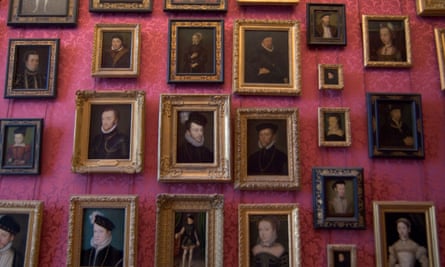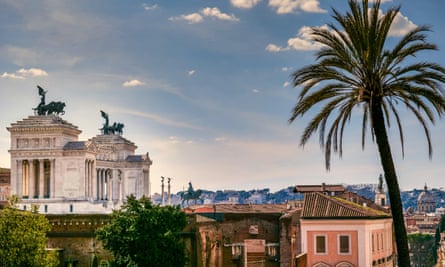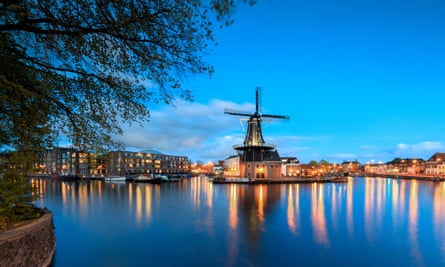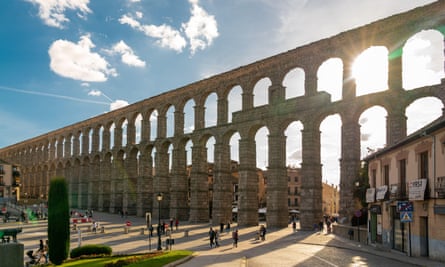
We wanted to pack a lot into our few days in Paris: Inventing Impressionism at the Musée d’Orsay (until 14 July), and, for my techie husband, the new Maison Poincaré maths museum near the Sorbonne (monoglot polymaths can relax: it’s bilingual). We’d been too late to book for Serge Gainsbourg’s house on the Left Bank (already sold out for 2024!) but the new Quai de la Photo floating contemporary photography museum was showing work by the late Jane Birkin’s daughter, Kate Barry. We also wanted to wander round galleries in newly arty Rue Béranger in the Marais and maybe catch Franco-Gabonese artist Myriam Mihindou at Musée du Quai Branly.
We had a shock, however, when we looked for somewhere to stay. Paris hotels are now so expensive: €300 a night is not uncommon. Then we hit on a cool solution: stay outside the capital, but on a fast train line. The small town of Chantilly is known for whipped cream, horse racing and fine handmade lace, and is less than half an hour (about €5 each way) from Gare du Nord.
We based ourselves at Hotel Le Chantilly (doubles from €130 B&B), an 18th-century coaching inn 10 minutes’ walk from Chantilly station, with original beams, wooden floors and exposed stone. Breakfasts were top-notch, and our room looked out on the creamy stone of Place Omer Vallon. There are cheaper places in the town, but this offered style and luxury we could never afford in the capital.
The added joy of this plan was that as well as getting our culture fix, we could explore a different, less-frenetic area. Just how gobsmacking the Château de Chantilly is shows in the fact that Valentino chose it as the backdrop for its 2023 show. (It was also the home of Bond villain Max Zorin in A View to a Kill.) The grounds were designed by André Le Nôtre, who also laid out the gardens at Versailles. The chateau was destroyed in the French Revolution, and its owner, the Duc d’Aumale, was later exiled to England, but when he returned he still had enough wealth and clout to rebuild and fill the rooms with art he’d collected while away. It’s now second only to the Louvre in France for old master paintings. We particularly enjoyed three luminous Raphaels and a lush Poussin landscape.
I have never seen horses more magnificently housed than in the chateau’s Great Stables, with cathedral-high ceilings and an indoor theatre space for daily equestrian demonstrations. Le Nôtre’s formal parterre is impressive, but the wider grounds, with woods, shady paths and lake are more enjoyable, nowhere more than the waterside Restaurant du Hameau, in the “Anglo-Chinese garden”, where we ate a simple but delicious lunch of charcuteries with crudités grown in the grounds.

After days spent in Paris, we tried out Chantilly’s restaurants. Le Jardin d’Hiver, in the posh Auberge du Jeu de Paume, not far from the chateau, does proper French fine dining (three courses from €59): confit chicory, scallops and a delicious veggie main of leek fondant with hazelnuts, gnocchi and preserved orange. More relaxed was Le Vertugadin, up the road from our hotel, where the rotund patron offers “bourgeois and virtuous” dishes (three courses €39, delicious but probably with too much butter and cream for real virtue). And when funds were running low, we ate tasty crepes (from €11) at La Cour Pavée.
We didn’t have time to go walking or riding in Chantilly Forest, or to visit the Potager des Princes, a peaceful garden with bamboo maze and free roaming peacocks and rabbits. And just a few miles away, the town of Senlis has half-timbered houses, a castle, a cathedral, and a Roman amphitheatre.
We’ll always have Paris, but here’s to looking at a whole new area, too.
Channel crossings were provided by Irish Ferries, which has returns Dover-Calais from £160 for a car and two passengers. The Chantilly stay was provided by Hauts de France Tourism
4 more towns within easy reach of European capitals
Potsdam for Berlin

The former capital of Prussian kings and Holy Roman Emperors has as many palaces, lakes and gardens as such a history would suggest, and is served by regional trains and the S-Bahn, with departures every few minutes to stations across Berlin (from €2). Also worth seeing are the Glienicke Bridge and the pretty houses of the Dutch Quarter. In between is Wannsee, which offers swims off lake beaches and ferries to the Pfaueninsel nature reserve, with its woodpeckers, cormorants and grazing buffalo. On a darker note, in 1942 Wannsee was the backdrop to the Nazi regime’s most infamous conference.
Hotel am Grossen Waisenhaus (doubles from €95 B&B) is in a baroque building, formerly an orphanage and later a children’s hospital, dating from the 1770s. It’s 20 minutes’ walk from the station and breakfast is a generous spread with enough fish, meat, eggs and fruit to set guests up for long days exploring Berlin.
Frascati for Rome
after newsletter promotion

The biggest town in the Castelli Romani is 30 minutes from Rome Termini (€2.10 each way) on a line once called il treno della sbornia (hangover train), as it was often full of Romans who’d spent the evening in the area’s famous fraschette and taverns. Around town there are several fancy Renaissance houses to visit, such as Villa Aldobrandini, with extensive gardens and a water theatre.
Villa Torlonia, which Mussolini rented for one lira a year as his state residence, closed in 1945 but its gardens and a museum reopened in 1978. Appropriately, it has been chosen as the site for Italy’s new Holocaust museum. Its Limonaia glasshouse, restored late last year, is now a focaccia bar, with tables in the garden (entrance on Via Renzo Felice).
Eating in Frascati used to be all traditional porchetta and cacio e pepe, but openings in the past two years have updated the offering, with innovative chefs such as Jacopo Ricci at DLR and Luca Ludovici at ConTatto moving back to their Castelli Romani roots. Hotel Flora (doubles from €105 room-only) is a wedding cake of a Liberty-style villa five minutes’ walk from the station.
Haarlem for Amsterdam

The historic capital of Noord-Holland province may be just 22 mins by train from Amsterdam Central (€4.90), but it has its own top-class architecture and culture, a pedestrianised old town surrounded by canals and the winding Spaarne River, and great independent shops. From the main square, Grote Markt, it’s a short walk to museums including Teylers, the oldest in the country, and Ten Boom House, where numerous Jews were hidden from the Nazis.
Nearby is Jopenkerk, a former church complete with stained-glass and barrel-vaulted roof that’s now a brewery and restaurant. Ten minutes by train in the other direction, Zandvoort has a huge west-facing sandy beach, perfect for long summer evenings.
On a quiet cobbled street near the station, Boutiquehotel Staats (doubles from €129 room-only) is a handsome redbrick former school with snazzy interiors.
Segovia for Madrid

With an impressive Roman aqueduct at the entrance to its old town, this Unesco-listed city is 55 miles north of Madrid, but linked by fast Renfe trains from Madrid Chamartín station (27 mins, from €10.50 each way). Segovia Guiomar station is south of the city, reached by bus 11 or 12.
Once there, sights include the Alcázar, a fairytale castle said by some to have inspired the Disneyland versions; the last gothic cathedral built in Spain, erected between 1525 and 1577; and the atmospheric Juderia (Jewish quarter), with shady squares and archways over cobbled lanes. Not to be missed is the small modern art gallery (in a 15th-century building) dedicated to Esteban Vicente, who died in 2001.
Segovia’s traditional cuisine is delicious but meat-heavy: it is known for cordero asado (roast lamb) and cochinillo asado (roast suckling pig). Try the latter at the cloister restaurant of Hotel San Antonio el Real, a converted monastery 15 minutes’ walk from the station. It also has doubles from €80 B&B.



